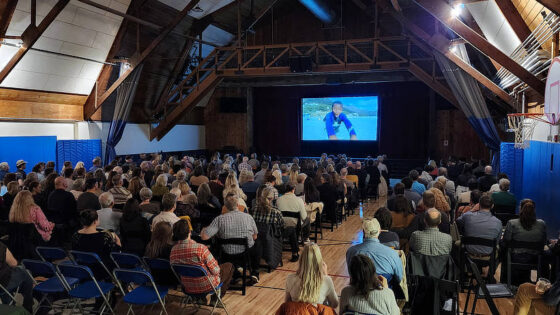By Mandy Nix and Tara Muenz (Reprinted from the 2020 Annual Report)
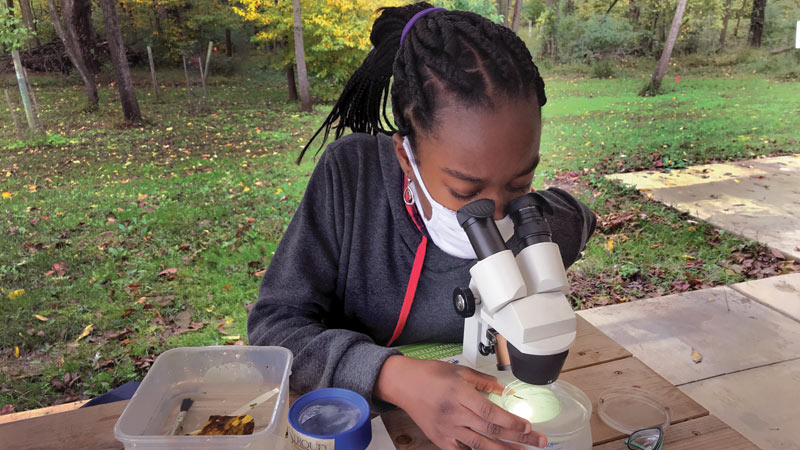
In Stroud Water Research Center’s education wing in early March, the air felt electric — but not with the familiar crackle of excitement as hundreds of students engulfed the campus for boots-in-the-water education.
“It felt like a storm was rolling in,” reflects Assistant Director of Education Tara Muenz. The “storm” was the viral disease that would define 2020: COVID-19. “I vividly remember being in my office as I heard of a rapidly spreading virus. I thought to myself, ‘A big shift is coming to our lives. One that will change us forever. One that will drive us to think, act, and instruct on an entirely different level than we ever have before.’”
The shift was a tectonic one, with global pandemic numbers rising by the minute and schools transitioning almost overnight into emergency remote learning conditions. When Muenz departed the Stroud Center that day, nimbus clouds hung like cobwebs over the parking lot. Muenz and 12 environmental education staff wouldn’t return for months.
Instead, they transfigured their personal homes into offices and virtual classrooms, invested in a suite of advanced educational technologies, and braced themselves for a pandemic that would shake foundational approaches to teaching.
Springing Into Global Action in a Digital Learning Landscape
Inquiry-driven learning is happening in real time in real places, but not always in person.
“During the coronavirus pandemic, teachable moments can be fostered on the screen rather than in the stream,” says Watershed Education Specialist Mandy Nix. Together with innovative education staff, Nix develops and delivers stream-to-screen virtual education programs for audiences of all ages. By combining live online instruction on video conferencing platforms like Zoom with prerecorded stream studies and watershed hikes, educators transport hands-on, minds-on learning to viewers’ homes.
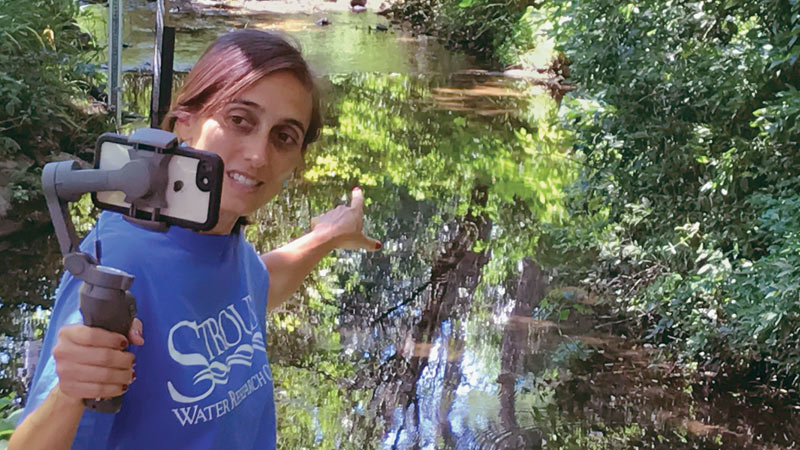
“While snacking at their kitchen-tables-turned-desks or curled up with their pets, ‘K through gray’ audiences can safely explore our 1,800-acre experimental watershed during stream-to-screen virtual education,” explains Nix. “They can still hike through our streamside forests and tally the aquatic insects that call our streams home. They can still observe caddisfly larvae crawling across the creekbed, and they can still discover a dragonfly nymph’s last molt stuck like cellophane to a sycamore trunk. They’re still getting an immersive learning experience — just from the other side of a computer screen!”
In 2020, virtual learning experiences comprised over 50% of Stroud Center education programming. Educators met immediate needs by sharing a suite of new and existing virtual learning resources, including the Stroud Center’s award-winning WikiWatershed Toolkit, in 17 education e-newsletters to readers worldwide. Carefully curated to engage audiences online or in nearby nature, these resources were shared on new webpages visited by viewers in 48 countries from every continent except Antarctica.
While tapping into remote learning more than ever before, 2020 also marked the debut of the new Leaf Pack Stream Ecology Kit. Improved metrics, identification tools, instructional videos, and digital learning tools supported stream studies worldwide — including over 500 miles away in Ontario, Canada. Kits were mailed right to the doorsteps of undergraduate students enrolled in a hybrid model of a Limnology of Natural and Polluted Water course at the University of Guelph.
Partnering for Greater Collective Impacts
To help bridge community-level and statewide barriers to environmental literacy and justice, the education department served on several national and statewide workgroups in 2020, including Pennsylvania Health Environment and Reopening Schools Workgroup; the National COVID-19 Outdoor Learning Committee; Updating Pennsylvania Science, Technology, and Environment and Ecology Standards; and the NOAA Pa. Environmental Literacy and Watershed Education Capacity-Building Task Force (NOAA Task Force). The Pennsylvania Association of Environmental Educators honored the NOAA Task Force with the 2020 Outstanding Environmental Education Program Award, which recognized the Task Force’s Pennsylvania Meaningful Watershed Educational Experience Ambassador Training Program for classroom teachers, school administrators, and non-formal educators.
“Students still get to experience fieldwork,” says Sheri Hincks, Department of Integrative Biology lab coordinator, who ordinarily wades knee-deep with students in Guelph’s Speed and Eramosa rivers to take physical and biological samples. During the pandemic, the Stroud Center’s kits are blended with virtual instruction to help students independently conduct water quality monitoring with aquatic macroinvertebrates. “This is real-life stuff that aquatic biologists would be doing.”
“However,” Nix points out, “the emergency learning landscape has also exposed and exacerbated the biggest cracks in our education systems worldwide — cracks like access to internet connectivity, advanced technologies, outdoor green space, and socioeconomic supports needed to succeed.”
These historic barriers mobilized educators like never before. Staff synthesized the very best digital, remote, and in-person teaching methods at their disposal, while also developing remote learning kits and tailored programming for local high-needs audiences and learners of all abilities. The result, says Nix, is “a patchwork quilt of our most vibrant, inclusive, and accessible environmental education yet.”
The department expanded their capacity to support global audiences, learners of all abilities, and marginalized communities during the pandemic and in preparation for the future.
Dipping Their Toes in the Water Again
Watershed education was not only fostered on the screen or in the mail. “After offering six months of entirely virtual programming for K–12 schools, universities, and adult audiences, while also growing our library of virtual learning resources, by fall 2020, there was a window of time to step back — lightly and literally — into the arena of in-person outdoor learning,” says Muenz.
Pulling from their contributions on the National COVID-19 Outdoor Learning Initiative and the Pennsylvania Healthy Environment and Reopening Schools Workgroup, as well as the best science available on pandemic safety, the department mapped scenarios and implemented data-driven safety procedures for in-person education programs. Throughout the fall, educators engaged audiences of all ages in on-the-water canoeing education and boots-in-the-water stream study education, all while adhering to rigorous sanitation protocols, physical distancing, and mask requirements.
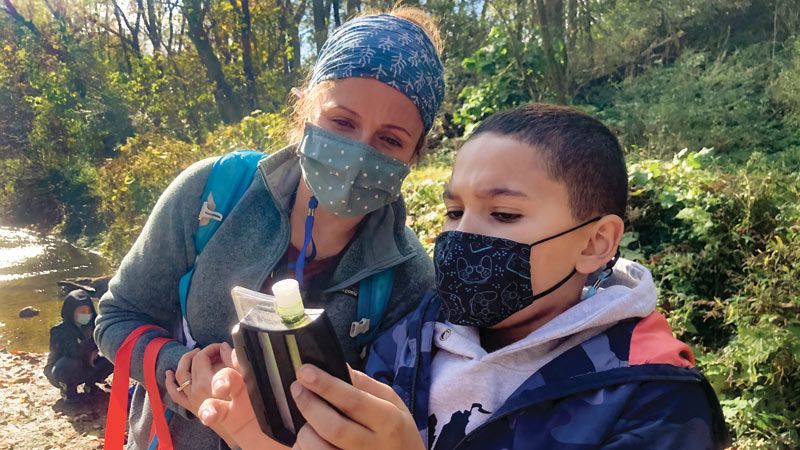
For teachers like Katie Harnish, fifth-grade teacher at Hambright Elementary School in Lancaster, Pennsylvania, these outdoor experiences opened critical pathways to “hands-on experiential learning in the midst of a pandemic.”
“The Stroud Center created a safe, physically distanced experience that allowed my students to explore, learn, and have lots of fun while maintaining stringent health protocols,” says Harnish. “My students’ experience was not only an engaging academic study. It also helped show them the beauty of the water in a way that has formed lasting connections between them and the natural world.”
Harnish’s students weren’t the only ones empowered by the natural world. “Like the incredible life cycles of aquatic insects we connect audiences to, our team’s secret to success and survival during the coronavirus pandemic was metamorphosis,” confesses Nix. “An insect doesn’t get its wings without profoundly disruptive, uncomfortable, and vulnerable transformation. We experienced those exact growing pains in 2020, while also building our long-term capacity for truly responsive education.”
In a year defined by global trauma and transformation, the education team spearheaded education initiatives for 14 new projects externally funded by federal, state, and local agencies with community-level and international impacts. By the time snow cloaked the Stroud Center campus in the last days of 2020, educators had successfully reached over 2,500 program participants around the world.
“There were moments throughout 2020 that were extremely challenging for our team, but if you focus on the positive and on what you can accomplish, you’ll never sink,” maintains Muenz. “Our educators used the opportunity and momentum to bring about creative, thoughtful, supportive programming with global significance and reach.”
Get Involved
On-site and off-site school and Scout programs for youth, professional development workshops for adults, and family programs in virtual, remote, and in-person settings are just some of our available education options.
Help us create new education programs and expand science beyond the classroom! Donate to the Future of Fresh Water Initiative and designate your gift to the Environmental Education Fund. Thanks to a $50,000 Challenge Match Grant by the Colket Family Foundation every gift will be doubled!
New Science Picture Book for Kids!
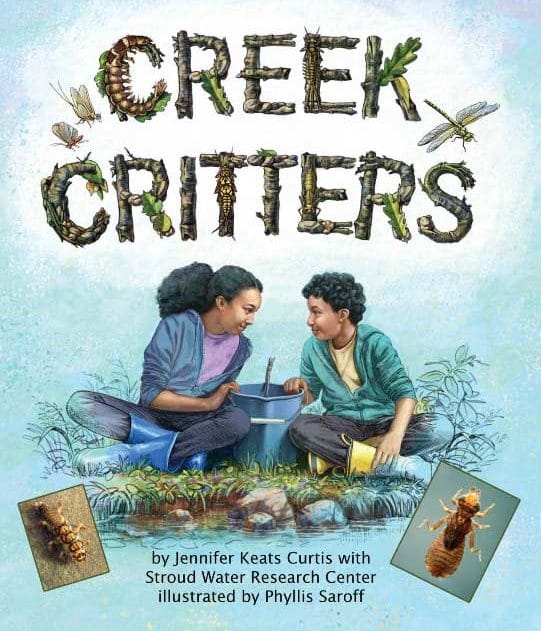
The education department kickstarted 2020 with the publication of Creek Critters or Animalitos de Arroyo, a multicultural STEM picture book written by Jennifer Keats Curtis in close collaboration with the Stroud Center’s Steve Kerlin, Mandy Nix, and Tara Muenz! Vibrantly illustrated by Phyllis Saroff, this engaging story follows two siblings on their quest to understand what aquatic macroinvertebrates can tell them about stream health. What will they find as they turn over rocks, sift through leaves, and explore the creekbed?
Creek Critters is available in English and Spanish with hardcover, paperback, and eBook options. Back-of-the-book activities, bilingual printables, and a teaching activity guide make this picture book a handy companion for exploring nearby nature.

Creek Critters was one of four finalists in the 2021 Hands-On Science Book category of the American Association for the Advancement of Science (AAAS) / Subaru SB&F Prize for Excellence in Science Books! This honor celebrates outstanding science writing and illustration for children and young adults.
CREEK CRITTERS® is a registered trademark of the Audubon Naturalist Society (ANS) of the Central Atlantic States, Inc. ANS’s CREEK CRITTERS mobile app helps people find and identify aquatic macroinvertebrates and report on stream health.



